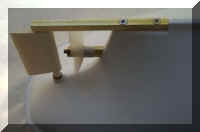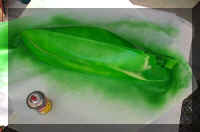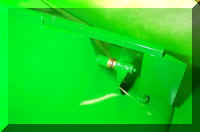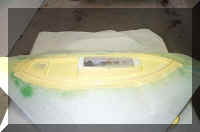| Put a small piece of tape over the Drive Dog
at the Stern Tube (Thrust) Bearing. This prevents paint from gumming up
the rotation of the prop. |
 |
| Blow away the dust. Lightly wipe with a Tack
Rag. (Rosin-impregnated gauze cloth available at most paint departments.)
In hot weather don't press too hard or rosin may rub off onto the plastic
hull. |
 |
| Don't hold the spray can too close. This
spray pattern, sprayed 5 inches from the spray nozzle, is too heavy at the center. |
 |
| At about 11 inches away, the pattern is more
even in coverage. The first coat should be very light to avoid drips and
sags. |
 |
| Imagine the area you are spraying is a flat
surface. Spray a pattern in overlapping rows left to right (or right to
left) in order to evenly cover that shape. If the surface is curved, then
curve your "stroke" keeping a constant distance from can to
object. With experience, you can spray back and forth. However, you don't
"zig-zag". Instead, spray straight across, move up (or down), then spray
back across. Don't move too fast. Take about 1-1/2 to 2 seconds per
pass. |
 |
| Here, the near side has been sprayed. There
are 5 sides to any object you paint. 4 sides and 1 top. Since you spray at
a slight downward angle, painting 4 sides will usually cover most of the
top portions. |
 |
| The two sides have been sprayed. These rear
end areas aren't covered by the side spray. Spray the stern end of the
hull. Don't forget the area forward of the Prop, under the Skeg. |
 |
| The only area of the front that the side
painting didn't cover is the thin area of the Keel at the bow. Don't point
and spray. The can must be moving when you press the nozzle. |
 |
| Look how thin the paint is. This is a good
first coat. Don't spray to a wet gloss. Just spray as even as you can. Let
it "flash" for about 15 minutes until dry to the touch.
"Flash" is a painting term meaning to allow the solvents in the
paint to evaporate. |
 |
| Note the over-spray on the paper. The first
line of paint was centered on the edge of the hull where it meets the
masking paper. The first coat of paint provides the foundation for the
heavier 2nd coat. It must be dry to the touch before applying the 2nd
coat. |
 |
| Spray the 2nd coat heavy enough to look wet
(gloss) and to look even. The first coat will help hold the 2nd in place until it flashes.
After two coats, you may have good coverage on the hull, and on the
masking paper as well. Some colors need 3 coats. If the 2nd coat doesn't
cover, resist the urge to keep spraying. Let the 2nd coat flash before
applying the 3rd coat. The 2nd coat will take twice as long to flash as the first
coat. |
 |
| There is enough paint in a small can to cover
the hull with 3 coats. I recommend 3 coats on the hull for better
durability. I often use only 2 coats (lighter colors) on the deck. |
 |
| Remove the tape at the bearing after the
paint dries. |
 |
| Hobby enamel fully cures in 3 days. However,
after a day or two of drying (depending on humidity & temperature) you
can turn it over to paint the deck. Put packaging tape over the hatch and
cabin opening. (Camera Boat deck shown.) |
 |
| In spraying the right side of the deck, look
carefully to find all of the surfaces that face to the right. To reach the
inside of the left Bulwark (side railing), aim down over the Cabin. |
 |
| From the stern, the areas that face rear are
shown. |
 |
| I have sprayed the right side. I sprayed the
whole oval area visible except for the top of the Cabin. (to save a little
paint) |
 |
| Turn the boat around and you will see what
was missed. From this side, I concentrate along the white areas. No need
to put additional coats on the deck surfaces that have a good first coat
already. |
 |
| After spraying both sides, it looks almost
done. |
 |
| However, when you look at the front, you see
the forward facing areas need paint. Avoid pointing and spraying. Use a
left-to-right pass, even for the tip of the bow. Don't forget the
step-down in front of the rear hatch, behind the cabin. |
 |
| Same with the stern. Paint this 4th
side. |
 |
| If the paint looks too thin on any of the top
surfaces, you can touch them up now. Repeat this 5-side spray technique
with the 2nd and, if necessary, 3rd coats. |
 |






















 TM
TM